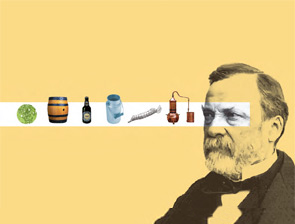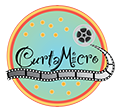 By: Ingrid da Silva Dias
By: Ingrid da Silva Dias
Text written for the “Scientific Communication Topics” subject of the Post-Graduate program in Science (Microbiology) at the Paulo de Góes Microbiology Institute
Microbiology as we know it today was only made possible when in the year 1674 Antonie Van Leeuwenhoek, a Dutch[C1] scientist, created the first microscope. He used a small device (microscope) that he had invented to observe small beings in soil, river-water, saliva and feces samples, which he named "animalcules". That same year Leeuwenhoek wrote several letters to the Royal Society in London describing the beings he saw through his small microscope. It was these letters that were the birth of microbiology; after all, it was these letters that opened the eyes of the Royal Society to become aware of the existence of small microscopic beings.
Two controversial theories arose from Leeuwenhoek’s discovery. The first was the theory of abiogenesis (spontaneous generation), where scientists, who defended this theory, believed that "animalcules" originated in the composition of plants and tissues of various animals. And the second was the theory of biogenesis which was much favored by the French scientist Louis Pasteur, who demonstrated the impossibility of spontaneous generation in two experiments. In the first experiment he took several jars and filled them with beef broth and boiled them; then he left them open to cool down. In a few days Pasteur noted that all the flasks had been contaminated with microbes; while those that he had kept closed after being boiled, were free from contamination. Thus Pasteur came to the conclusion that the microbes were present in the air and that they were responsible for the contamination. In the second experiment, he put half the culture in jars with S-shaped necks, and he proceeded just as he had done in the previous experiment, boiled the jars and then he left them to cool down. After months of waiting Pasteur did not observe any form of life in jars with the S-shaped necks and thus he concluded that the S shaped neck prevented any microbe that was present in the air to contact the culture medium. Pasteur's experiments demonstrated that microbes cannot arise from nonliving matter. Louis Pasteur contributed greatly to the advancement of microbiology. He produced various important works and created several theories. In his Fermentation theory Pasteur explained why contamination by alcohol occurred during the fermentation process; he discovered the presence of various microbes, called yeasts, which used the sugar present in fruits and converted it into alcohol in the absence of oxygen. While in the presence of oxygen the drinks became acidic due to the presence of different microbes that transform the alcohol into acetic acid, commonly known as vinegar. In order to overcome this problem that afflicted traders and wine producers, Pasteur heated these drinks long enough to kill these microbes, which were causing the problem and this process is named Pasteurization after its creator. After Pasteur had discovered the fermentation process and the reasons behind it, some scientists warned the Royal Society of the possibility that microbes (germs) were associated with diseases effecting animals and humans and this theory was called the germ theory of disease.The Royal Society found it difficult to comprehend and understand the germ theory of disease, because at that time many believed that diseases were God's way of punishing them for their sins.
In the year 1860, Joseph Lister an English physician, who was born in 1827, appeared on the scene. He shared the same thoughts as Pasteur and believed that the microbes present in the air, were responsible for various infections. Lister, then turned his attention to create a method of disinfecting the operating theater and proposed that during surgery carbolic acid should be sprayed on the site of the surgical intervention. This method was first used in the year 1865, during the operation of a boy who had suffered an open fracture. After the adoption of this method by several health professionals the number of deaths from postoperative infection greatly diminished.
Eleven years after the adoption of the Lister method, more precisely in the year 1876, a German physician named Robert Koch finally managed to link microbes with diseases. In the same year he published the Koch's postulates[C2] : First postulate, said that a microorganism must be found in abundance in all organisms suffering from the disease, but should not be found in healthy organisms; this was what Koch called host-pathogen interaction. His second postulate stated that a microorganism must be isolated from a diseased organism and grown in pure culture (pathogen isolation). His third postulate stated that a cultured microorganism should cause disease when introduced into a healthy organism (pathogen inoculation and reproduction of symptoms). And his fourth and last postulate stated that a microorganism must be reisolated from the inoculated, diseased experimental host and identified as being identical to the original specific causative agent (the reisolation of pathogens).
Alexander Fleming, a Scottish bacteriologist and doctor, took great interest in microbiology and lived in his lab studying the work of other doctors who treated serious injuries with an antiseptic of their choice. He noted that the carbolic acid used by Lister, affected the WBCs more than the microbes themselves. So Fleming started using brines in order to attract white blood cells; he believed that the body's defenses should receive greater attention and thus carried out experiments, in which he cultivated many microbes in order to test various antiseptics and their modes of action. In one of these experiments conducted in 1928, more precisely with Staphylococci, he noticed that on one of his plates a fungus had grown and that around this fungus the microbe did not grow. Fleming decided to study this fungus a little more closely and examined it carefully, where upon he managed to describe it and identify it as Penicillium, and noted that the fungus produced a substance which could be treated, isolated and filtered and that it hindered the growth of various microbes on the plates.
Fleming reproduced the experiment several times and noted that the substance produced by the fungus was able to inhibit the growth of microbes that caused disease, and since this substance had been isolated from the fungus Penicillium, was named Penicillin.
Microbiology is a science, which is very important when considered as an applied science. Highlighted are its uses in numerous industrial processes such as food production, pest control, food quality control, production of antibiotics, hormones, enzymes, and in depollution among others.
References:
Source:http://www.infoescola.com/biografias/alexander-fleming/ file:///E:/Material%20para%20a%20mat%E9ria%20do%20portal%20da%20micro/Biblioteca%20Virtual%20Adolpho%20Lutz.html
file:///E:/Material%20para%20a%20mat%E9ria%20do%20portal%20da%20micro/Teoria%20microbiana%20das%20doen%E7as_%20a%20grande%20virada%20no%20conhecimento.html
http://educacao.uol.com.br/biografias/joseph-lister.jhtm
http://pt.wikipedia.org/wiki/Postulados_de_Koch
Jornal Brasileiro de Patologia Médica Laboratorial- Antony Van Leeuwenhoek-Inventor do Microscópio, volume 45, n.2,2009.
Jornal Brasileiro de Patologia Médica Laboratorial-Alexander Fleming e a descoberta da penicilina,volume45,n.5,2009.
file:///E:/Material%20para%20a%20mat%E9ria%20do%20portal%20da%20micro/Os%20experimentos%20de%20Pasteur%20-%20S%F3%20Biologia.html
http://www.portaleducacao.com.br/farmacia/artigos/16899/importancia-da-Microbiologia

















